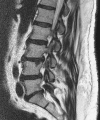Schmorl's nodes
- PMID: 22544358
- PMCID: PMC3481099
- DOI: 10.1007/s00586-012-2325-9
Schmorl's nodes
Abstract
Introduction: First described in 1927, a Schmorl's node (SN) is the herniation of nucleus pulposus (NP) through the cartilaginous and bony end plate into the body of the adjacent vertebra. SNs are common findings on imaging, and although most SNs are asymptomatic, some have been shown to become painful lesions. In this manuscript, we review the literature regarding the epidemiology, clinical presentation, pathogenesis, imaging, and management of SNs.
Materials and methods: Using databases from the US National Library of Medicine and the National Institutes of Health, relevant articles were identified.
Results: While several theories regarding the pathogenesis of SNs have been proposed, an axial load model appears to have the greatest supporting evidence. Symptomatic SNs are thought to be due to the inflammatory response solicited by the herniation of NP into the well-vascularized vertebral body. Management options for symptomatic SNs vary, ranging from medical management to surgical fusion.
Conclusion: SNs are common lesions that are often asymptomatic. In certain cases, SNs can cause back pain. No consensus on pathogenesis exists. There is no established treatment modality for symptomatic SNs.
Figures
References
-
- Schmorl G. Uber die an den wirbelbandscheiben vorkommenden ausdehnungs–und zerreisungsvorgange und die dadurch an ihnen und der wirbelspongiosa hervorgerufenen veranderungen. Verh Dtsch Path Ges. 1927;22:250.
-
- Schmorl G, Junghanns H. The human spine in health and disease. 2. New York: Grune and Stratton; 1971.
-
- Coventry MB, Ghormley RK, Kernohan JW. The intervertebral disc: its microscopic anatomy and pathology. Part I. Anatomy, development, and physiology. J Bone Joint Surg Am. 1945;27:105–112.
Publication types
MeSH terms
Supplementary concepts
LinkOut - more resources
Full Text Sources
Medical
Miscellaneous


